
These images, taken with the SPHERE instrument on ESO’s Very Large Telescope, show the surface of the red supergiant star Betelgeuse during its unprecedented dimming, which happened in late 2019 and early 2020. The image on the far left, taken in January 2019, shows the star at its normal brightness, while the remaining images, from December 2019, January 2020, and March 2020, were all taken when the star’s brightness had noticeably dropped, especially in its southern region. The brightness returned to normal in April 2020. Credit: ESO/M. Montargès et al.
Mystery of Betelgeuse’s Dip in Brightness Solved
When Betelgeuse, a bright orange star in the constellation of Orion, became visibly darker in late 2019 and early 2020, the astronomy community was puzzled. A team of astronomers have now published new images of the star’s surface, taken using the European Southern Observatory’s Very Large Telescope (ESO’s VLT), that clearly show how its brightness changed. The new research reveals that the star was partially concealed by a cloud of dust, a discovery that solves the mystery of the “Great Dimming” of Betelgeuse.
Betelgeuse’s dip in brightness — a change noticeable even to the naked eye — led Miguel Montargès and his team to point ESO’s VLT towards the star in late 2019. An image from December 2019, when compared to an earlier image taken in January of the same year, showed that the stellar surface was significantly darker, especially in the southern region. But the astronomers weren’t sure why.
The team continued observing the star during its Great Dimming, capturing two other never-before-seen images in January 2020 and March 2020. By April 2020, the star had returned to its normal brightness.
When Betelgeuse, a bright orange star in the constellation of Orion, became visibly darker in late 2019 and early 2020, the astronomy community was puzzled. A team of astronomers have now published new research done with ESO’s Very Large Telescope and Very Large Telescope interferometer that solves the mystery of Betelgeuse’s dimming. This ESOcast Light summarizes the discovery. Credit: ESO
“For once, we were seeing the appearance of a star changing in real time on a scale of weeks,” says Montargès, from the Observatoire de Paris, France, and KU Leuven, Belgium. The images now published are the only ones we have that show Betelgeuse’s surface changing in brightness over time.
In their new study, published today (June 16, 2021) in the journal Nature, the team revealed that the mysterious dimming was caused by a dusty veil shading the star, which in turn was the result of a drop in temperature on Betelgeuse’s stellar surface.
This animation combines four real images of the red supergiant star Betelgeuse, the first taken in January 2019 and the others taken in December 2019, January 2020 and March 2020, during the star’s unprecedented dimming. All images, which allow us to resolve the surface of the star, were taken with the SPHERE instrument on ESO’s Very Large Telescope. Astronomers were puzzled to see Betelgeuse’s brightness decrease, but later found that it was caused by a “dusty veil” that partially concealed the southern part of the star. Credit: ESO/M. Montargès et al./L. Calçada
Betelgeuse’s surface regularly changes as giant bubbles of gas move, shrink and swell within the star. The team concludes that some time before the Great Dimming, the star ejected a large gas bubble that moved away from it. When a patch of the surface cooled down shortly after, that temperature decrease was enough for the gas to condense into solid dust.
“We have directly witnessed the formation of so-called stardust,” says Montargès, whose study provides evidence that dust formation can occur very quickly and close to a star’s surface. “The dust expelled from cool evolved stars, such as the ejection we’ve just witnessed, could go on to become the building blocks of terrestrial planets and life,” adds Emily Cannon, from KU Leuven, who was also involved in the study.

This image shows the location of the red supergiant star Betelgeuse in the constellation of Orion (the Hunter). Betelgeuse can be seen quite easily without the need for a telescope as the right shoulder of Orion, as highlighted in this diagram. Credit: ESO/N. Risinger (skysurvey.org)
Rather than just the result of a dusty outburst, there was some speculation online that Betelgeuse’s drop in brightness could signal its imminent death in a spectacular supernova explosion. A supernova hasn’t been observed in our galaxy since the 17th century, so present-day astronomers aren’t entirely sure what to expect from a star in the lead-up to such an event. However, this new research confirms that Betelgeuse’s Great Dimming was not an early sign that the star was heading towards its dramatic fate.
This artist’s animation shows a close-up view of Betelgeuse’s irregular surface — with its giant, dynamic gas bubbles — and distant stars dotting the background. As the “virtual camera” rotates from right to left we see a dusty clump, which condensed from gas released by the star, obscuring the southern region of Betelgeuse from different vantage points. When the red supergiant star Betelgeuse became visibly darker in late 2019 and early 2020, astronomers were puzzled. Thanks to a new study conducted with ESO telescopes, we now know that Betelgeuse’s dip in brightness was the result of a “dusty veil” that formed from material that emerged from the star, partially concealing its southern region. The new research shows that the star likely ejected a large gas bubble that moved away from it; when a patch of the surface (in dark in the animation) cooled down shortly after, that temperature decrease was enough for the gas to condense into solid dust. Credit: ESO/L. Calçada
Witnessing the dimming of such a recognizable star was exciting for professional and amateur astronomers alike, as summed up by Cannon: “Looking up at the stars at night, these tiny, twinkling dots of light seem perpetual. The dimming of Betelgeuse breaks this illusion.”
The team used the Spectro-Polarimetric High-contrast Exoplanet REsearch (SPHERE) instrument on ESO’s VLT to directly image the surface of Betelgeuse, alongside data from the GRAVITY instrument on ESO’s Very Large Telescope Interferometer (VLTI), to monitor the star throughout the dimming. The telescopes, located at ESO’s Paranal Observatory in Chile’s Atacama Desert, were a “vital diagnostic tool in uncovering the cause of this dimming event,” says Cannon. “We were able to observe the star not just as a point but could resolve the details of its surface and monitor it throughout the event,” Montargès adds.

This chart shows the location of the very bright red supergiant star Betelgeuse (Alpha Orionis) in the famous constellation of Orion (The Hunter). This map shows most of the stars visible to the unaided eye under good conditions and the star itself is marked with a red circle. Although the star itself is clearly visible to the unaided eye, the nebula around it cannot be seen visually with any telescope. Credit: ESO, IAU and Sky & Telescope
Montargès and Cannon are looking forward to what the future of astronomy, in particular what ESO’s Extremely Large Telescope (ELT), will bring to their study of Betelgeuse, a red supergiant star. “With the ability to reach unparalleled spatial resolutions, the ELT will enable us to directly image Betelgeuse in remarkable detail,” says Cannon. “It will also significantly expand the sample of red supergiants for which we can resolve the surface through direct imaging, further helping us to unravel the mysteries behind the winds of these massive stars.”
This video takes the viewer from the constellation of Orion to the surface of the supergiant star Betelgeuse, which underwent an unprecedented dimming in late 2019 and early 2020. As we zoom closer to the star, we see the star’s “flames”: clouds of dust captured in a dramatic image taken with the VISIR instrument on ESO’s Very Large Telescope. The dot appearing at the end of the zoom is a March 2020 image taken with the SPHERE instrument on ESO’s Very Large Telescope showing Betelgeuse’s visible surface, which has a size close to that of the orbit of Jupiter. Credit: ESO/P. Kervella/M. Montargès et al., Digitized Sky Survey 2. Acknowledgment: E. Pantin, N. Risinger (skysurvey.org). Music: J. B. Monell (www.johanmonell.com)
Reference: “A dusty veil shading Betelgeuse during its Great Dimming” by M. Montargès, E. Cannon, E. Lagadec, A. de Koter, P. Kervella, J. Sanchez-Bermudez, C. Paladini, F. Cantalloube, L. Decin, P. Scicluna, K. Kravchenko, A. K. Dupree, S. Ridgway, M. Wittkowski, N. Anugu, R. Norris, G. Rau, G. Perrin, A. Chiavassa, S. Kraus, J. D. Monnier, F. Millour, J.-B. Le Bouquin, X. Haubois, B. Lopez, P. Stee and W. Danchi, 16 June 2021, Nature.
DOI: 10.1038/s41586-021-03546-8
The team is composed of M. Montargès (LESIA, Observatoire de Paris, Université PSL, CNRS, Sorbonne Université, Université de Paris France [LESIA] and Institute of Astronomy, KU Leuven, Belgium [KU Leuven]), E. Cannon (KU Leuven), E. Lagadec (Université Côte d’Azur, Observatoire de la Côte d’Azur, CNRS, Laboratoire Lagrange, Nice, France [OCA]), A. de Koter (Anton Pannekoek Institute for Astronomy, University of Amsterdam, The Netherlands and KU Leuven), P. Kervella (LESIA), J. Sanchez-Bermudez (Max Planck Institute for Astronomy, Heidelberg, Germany [MPIA] and Instituto de Astronomía, Universidad Nacional Autónoma de México, Mexico City, Mexico), C. Paladini (European Southern Observatory, Santiago, Chile [ESO-Chile]), F. Cantalloube (MPIA), L. Decin (KU Leuven and School of Chemistry, University of Leeds, UK), P. Scicluna (ESO-Chile), K. Kravchenko (Max Planck Institute for Extraterrestrial Physics, Germany), A. K. Dupree (Center for Astrophysics | Harvard & Smithsonian, Cambridge, MA, USA), S. Ridgway (NSF’s NOIRLab, Tucson, AZ, USA), M. Wittkowski (European Southern Observatory, Garching bei Munchen, Germany [ESO-Garching]), N. Anugu (Steward Observatory, University of Arizona, Tucson, AZ, USA and School of Physics and Astronomy, University of Exeter, UK [Exeter]), R. Norris (Physics Department, New Mexico Institute of Mining and Technology, Socorro, USA), G. Rau (NASA Goddard Space Flight Center, Exoplanets & Stellar Astrophysics Laboratory, Greenbelt, MD, USA [NASA Goddard] and Department of Physics, Catholic University of America, Washington, DC USA), G. Perrin (LESIA), A. Chiavassa (OCA), S. Kraus (Exeter), J. D. Monnier (Department of Astronomy, University of Michigan, Ann Arbor, MI, USA [Michigan]), F. Millour (OCA), J.-B. Le Bouquin (Univ. Grenoble Alpes, CNRS, IPAG, Grenoble, France and Michigan), X. Haubois (ESO-Chile), B. Lopez (OCA), P. Stee (OCA), and W. Danchi (NASA Goddard).
ESO is the foremost intergovernmental astronomy organization in Europe and the world’s most productive ground-based astronomical observatory by far. It has 16 Member States: Austria, Belgium, the Czech Republic, Denmark, France, Finland, Germany, Ireland, Italy, the Netherlands, Poland, Portugal, Spain, Sweden, Switzerland and the United Kingdom, along with the host state of Chile and with Australia as a Strategic Partner. ESO carries out an ambitious program focused on the design, construction and operation of powerful ground-based observing facilities enabling astronomers to make important scientific discoveries. ESO also plays a leading role in promoting and organizing cooperation in astronomical research. ESO operates three unique world-class observing sites in Chile: La Silla, Paranal and Chajnantor. At Paranal, ESO operates the Very Large Telescope and its world-leading Very Large Telescope Interferometer as well as two survey telescopes, VISTA working in the infrared and the visible-light VLT Survey Telescope. Also at Paranal ESO will host and operate the Cherenkov Telescope Array South, the world’s largest and most sensitive gamma-ray observatory. ESO is also a major partner in two facilities on Chajnantor, APEX and ALMA, the largest astronomical project in existence. And on Cerro Armazones, close to Paranal, ESO is building the 39-meter Extremely Large Telescope, the ELT, which will become “the world’s biggest eye on the sky.”









Be the first to comment on "Astronomers Were Puzzled by “Great Dimming” of Betelgeuse – Now the Mystery Is Solved"